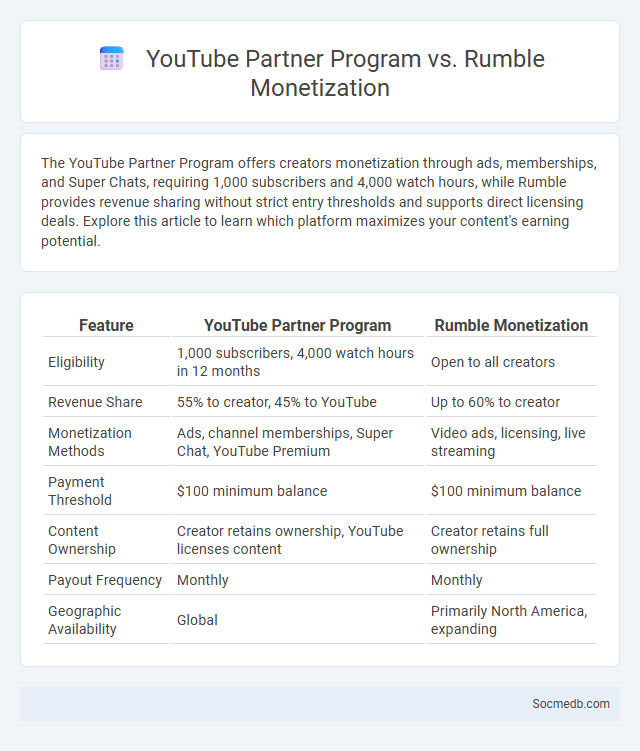
Photo illustration: YouTube Partner Program vs Rumble Monetization
The YouTube Partner Program offers creators monetization through ads, memberships, and Super Chats, requiring 1,000 subscribers and 4,000 watch hours, while Rumble provides revenue sharing without strict entry thresholds and supports direct licensing deals. Explore this article to learn which platform maximizes your content's earning potential.
Table of Comparison
| Feature | YouTube Partner Program | Rumble Monetization |
|---|---|---|
| Eligibility | 1,000 subscribers, 4,000 watch hours in 12 months | Open to all creators |
| Revenue Share | 55% to creator, 45% to YouTube | Up to 60% to creator |
| Monetization Methods | Ads, channel memberships, Super Chat, YouTube Premium | Video ads, licensing, live streaming |
| Payment Threshold | $100 minimum balance | $100 minimum balance |
| Content Ownership | Creator retains ownership, YouTube licenses content | Creator retains full ownership |
| Payout Frequency | Monthly | Monthly |
| Geographic Availability | Global | Primarily North America, expanding |
Overview of YouTube Partner Program
The YouTube Partner Program (YPP) enables content creators to monetize their videos through ads, channel memberships, and Super Chat features. Eligibility requires a minimum of 1,000 subscribers and 4,000 watch hours in the past 12 months, ensuring active and engaged audiences. YouTube provides creators with revenue sharing, detailed analytics, and access to copyrighted content management tools to optimize earnings.
Introduction to Rumble Monetization
Rumble Monetization offers content creators a unique platform to earn revenue through video views, sponsorships, and ad placements. Rumble's algorithm promotes your videos to a wide audience, enhancing your potential income by maximizing engagement and visibility. Leveraging Rumble's monetization tools can transform your social media content into a profitable digital asset.
Partner Program: Key Features and Eligibility
The Social Media Partner Program offers exclusive tools for content creators, including monetization options, advanced analytics, and priority support designed to enhance your channel growth. Eligibility requires consistent content quality, adherence to platform guidelines, and a minimum number of followers or engagement metrics, ensuring only dedicated users benefit from the program. By joining, you gain access to brand collaboration opportunities and revenue streams that maximize the impact of your social media presence.
Revenue Streams: YouTube vs Rumble vs Partner Programs
YouTube generates significant revenue through ads, channel memberships, Super Chats, and YouTube Premium subscriptions, leveraging its vast global user base and advanced ad targeting. Rumble monetizes primarily via ad revenue sharing, licensing deals, and offering creators a larger percentage of earnings to attract high-quality content. Partner programs on both platforms provide creators with monetization opportunities, but YouTube's established ecosystem affords greater income potential through diversified streams and brand partnerships.
Application Process and Requirements
To apply for a social media role, you typically need to submit a portfolio showcasing your content creation, analytics, and campaign management skills. Your application should include a resume highlighting experience with platforms like Facebook, Instagram, Twitter, and LinkedIn, along with proficiency in tools such as Hootsuite and Google Analytics. Meeting requirements often involves demonstrating knowledge of audience engagement strategies, SEO optimization, and data-driven decision-making.
Content Guidelines and Community Standards
Social media platforms enforce strict Content Guidelines and Community Standards to maintain a safe, respectful, and inclusive environment for users worldwide. These policies prohibit harmful content such as hate speech, misinformation, explicit material, and harassment, ensuring compliance with legal regulations and protecting user well-being. Enforcement mechanisms, including content moderation, user reporting, and algorithmic filtering, are continuously updated to address emerging challenges and promote responsible digital interactions.
Monetization Tools and Payment Methods
Social media platforms offer a variety of monetization tools such as sponsored content, affiliate marketing, subscription services, and in-app purchases, enabling creators to generate revenue directly from their audience. Popular payment methods integrated into these platforms include digital wallets, credit/debit cards, and mobile payment systems like PayPal, Apple Pay, and Google Pay, ensuring seamless and secure transactions. Advanced analytics and payout dashboards help users track earnings and optimize their content strategies for higher profitability.
Audience Reach and Platform Analytics
Social media platforms utilize advanced audience reach tools to target specific demographics, enhancing the effectiveness of marketing campaigns and expanding brand visibility. Platform analytics provide valuable insights into user engagement, content performance, and conversion metrics, enabling data-driven decision-making for optimizing strategies. Leveraging these analytics ensures continuous growth by identifying trends and maximizing return on investment across channels such as Facebook, Instagram, and Twitter.
Pros and Cons: YouTube, Rumble, and Other Partner Programs
YouTube offers vast reach and monetization through ads, memberships, and super chats but enforces strict content policies and faces demonetization challenges. Rumble provides creators with better revenue shares and content ownership while having a smaller audience and fewer monetization tools compared to YouTube. Other partner programs vary in revenue potential and community size, often balancing content control, monetization options, and discoverability in competitive social media landscapes.
Choosing the Best Platform for Content Monetization
Selecting the ideal social media platform for content monetization depends on your target audience, content type, and engagement goals. Platforms like YouTube excel in video monetization through ads and memberships, while Instagram and TikTok offer opportunities for brand partnerships and sponsored posts. Understanding each platform's monetization tools and audience demographics helps you maximize revenue potential effectively.
 socmedb.com
socmedb.com